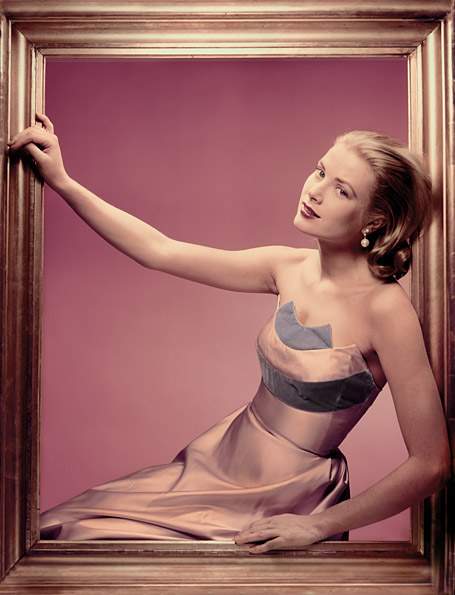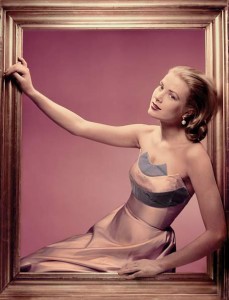Grace and style

by Lottie Johansson

Grace Kelly in 1955, the year before she married Prince Rainier of Monaco and moved to the principality as princess consort. Photograph by Erwin Blumenfeld, New York 1955
If you are visiting a major city and in need of a shot of culture, instead of an art show you might choose to see a fashion exhibition such as Grace Kelly: Style Icon, newly opened at the Victoria & Albert Museum in London. You would not be alone: the number of people attending fashion exhibitions at art galleries and fashion institutions around the world has increased considerably over the past few years. And we are not just talking fashion insiders here; these shows attract a wide demographic audience.
With recent inspiring and diverse shows such as The Golden Age of Couture at the V&A, Superheroes: Fashion & Fantasy at the Metropolitan Museum of Modern Art in New York and the Madeleine Vionnet exhibition at the Decorative Arts at the Louvre in Paris drawing record-breaking crowds, this is very much the age of the blockbuster fashion show.
Valerie Steele, the director and chief curator of the Museum at the Fashion Institute of Technology (MFIT) in New York, says: “Not everyone feels they know enough about art to be interested in art, but everyone puts on clothes and has some kind of connection with fashion. So that means potentially that fashion shows are much more popular.”
The Giorgio Armani Exhibition at the Triennale in Milan in 2007 closed to great acclaim and Armani commented: “It was a huge honour to be the subject of the museum’s first exhibition dedicated to the work of a single designer. Fashion is central to human self-expression and perfectly reflects both society and its culture.”
The Design Museum in London has staged monographic exhibitions on several designers, including Matthew Williamson and Hussein Chalayan, and its next major show, 100 years of Fashion Illustration, opens in November. “These shows generate significant amounts of media coverage,” explains the museum’s head of curatorial, Donna Loveday. “Furthermore, exhibitions with global brands in their titles have broad appeal and virtually guarantee huge interest. A significant part of these audiences are made up of 16-25-year-olds, a group notoriously difficult for museums to attract.”
Steele agrees. “At MFIT we look for things that are fashion-forward and have that element of creativity and novelty. We aren’t restricted to saying that only high fashion like haute couture qualifies as the original art object. We’re just as interested in punk or gothic style that is going to push fashion forward. We had a huge audience for Gothic: Dark Glamour last year. That was our most popular show ever.”
Diana Vreeland is credited with masterminding the birth of the blockbuster fashion show at the Met in the 1970s and 1980s, along with the museum’s director, Tom Hoving. Previously the editor-in-chief of American Vogue, Vreeland was put in charge of the Costume Institute at the Met and proceeded to turn the concept of the fashion exhibition on its head, staging a crowd-pulling series of shows, including The World of Balenciaga in 1973 and The Glory of Russian Costume in 1976. Her 1983 retrospective of Yves Saint Laurent was controversial as it was the first time a museum had staged a show of a living designer’s work. It proved an instant hit.
Harold Koda, the current curator in charge of the Costume Institute at the Met, worked for Vreeland and observes: “Prior to her shows there was always a more limited captive audience for costume exhibitions, and primarily female, more interested in a social history context rather than the conceiving of fashion as a purely aesthetic enterprise. Vreeland isolated the objects so they became part of a narrative of history, presented as entrancing design pieces in themselves.
“At the same time, the V&A took a very different strategy and reinstalled its dress corps, doing historical presentation of the costumes,” Koda adds. “So you had two of the most important costume collections in the world providing a very different approach. Because of the excitement that both elicited, fine arts museums with a costume and textiles component saw it as a way of reaching a very broad audience. Since then, the popularity of fashion shows is just beyond anyone’s expectation.”
Today, thanks to media, celebrity, brand awareness and a flourishing interest in the arts, fashion exhibitions are as much about entertainment as about educating and reflecting social, gender and political issues. “Exhibitions now are seen as drama in their presentation and might well include scenery, props, mood backdrops and music to enhance the complete experience,” says the fashion commentator Tony Glenville.
Location also plays a huge role in the success of an exhibition and an institution’s fashion collection.
Pamela Golbin, the chief curator of decorative arts, in charge of the fashion and textile collection at the Louvre, says: “Because we are in Paris, we work directly with the designers and ask them for the samples that actually go on the catwalk. The gallery is allotted to us by the government and our collections are national, so we show as much as we can of the pieces we own.”
The museum’s unique collection of Madeleine Vionnet samples was bequeathed by the designer in 1952 and was seen for the first time at last year’s show. “Vionnet was fundamentally able to bring perfection to her field and you can’t remain indifferent to perfection,” says Golbin. “The audience was in awe of her work and it was the first time that people returned multiple times to see an exhibition.”
Unusually, the Vionnet show ran for seven months, rather than the traditional three to four. This was facilitated by the museum’s state of the art galleries, which reopened in 1997. According to Golbin: “Our gallery spaces were conceived to be able to show garments for much longer. As all of the pieces are encased, it gives a certain security, but also controls the atmosphere.”
The time limit for fashion exhibitions can also be dependent on private lenders requesting that their pieces rest between shows. “Especially if they are historical objects,” explains the leading milliner Stephen Jones, whose recent Hats: An Anthology by Stephen Jones exhibition at the V&A attracted a huge audience. “The dyes are often fugitive, so they need to be conserved in the darkness for a while. It’s the same with my hats.”
Jones’s show, co-curated by the V&A’s Oriole Cullen, has just transferred to the Queensland Art Gallery in Brisbane. “It was very important that my show had a broad appeal,” comments Jones. “Fashion has great entertainment value and can be understood by a lot of people and museums are always trying to attract a younger audience. For example, if you look at something like the V&A’s Kylie exhibition, it attracted a lot of people who would never normally have gone to the museum.”
Koda recalls a similar experience at the Met. “When we did the Jacqueline Kennedy: The White House Years show in 2001, it broke attendance records. There were people coming, not only to see the clothes, but to immerse themselves in the idea of the First Lady. Then there were others who came to assimilate the history of a period; that through the life and dress of one woman they could understand a certain moment in political history. It was a show that really attracted people who perhaps didn’t have a primary interest in the traditional fine arts.
“Once you introduce people to that environment they can’t help being seduced by the Monet down the hall or the extraordinary Rodin sculpture they are passing.”
Koda adds: “I think in terms of many art museums there’s this sense that the chilly authority of fine art is broken when people come in to see something much more familiar.”
Fashion’s appeal is that it addresses people across generations and from all walks of life, as the V&A’s new and highly publicised show will attest. Grace Kelly: Style Icon explores the fairy-tale life of one of Hollywood’s most glamorous leading ladies, an Oscar-winner who married Prince Rainier of Monaco.
“There have been exhibitions on Grace Kelly’s life, but as the world’s leading museum of art and design, we felt we wanted to show her wardrobe and really focus in, using the clothes, jewellery, hats, gloves and bags that survive to show how her style was put together,” explains Jenny Lister, the curator of Fashion and Textiles.
“Of course, we also tell the extraordinary story of her life as a model, actress, bride and princess through all the outfits, pictures and film. This feels like the right time to look at Grace Kelly and her influence on fashion – many people may have only heard of a few of her films, and not be aware of the full story.”
The exhibition includes some of Kelly’s definitive couture pieces by Marc Bohan at Christian Dior, Balenciaga, Yves Saint Laurent and her famous Hermès Kelly bag. “Perhaps it was due to her modelling days, but Grace Kelly really knew how to put her look together – she always looked elegant, demure, and was always immaculately groomed,” comments John Galliano, the creative director at Dior, “She was a princess before she married royalty and remains very much a style icon as much as a Dior patron. She understood clothes, luxury, quality… there are so many images of her where her look captures an era.”
Sponsored by Van Cleef & Arpels, the exhibition also shows much of Kelly’s jewellery. “Femininity, grace, elegance, naturalness and a kind of obvious simplicity are part of Princess Grace’s style and also define Van Cleef & Arpels’ designs,” explains Stanislas de Quercize, the chief executive and president of Van Cleef & Arpels.
A key factor in the success of an exhibition is timing. Says Glenville: “I think it is a wonderful synchronicity that as Mad Men is on our screens fashion is turning towards the ladylike; this V&A exhibition and Grace Kelly should be so in the public eye. A happy chance or meticulous planning?”
The MFIT has scheduled a show on the eccentric British socialite Daphne Guinness next September. “There are lots of women who are interested in fashion and who are fashionable,” says Steele. “What Daphne’s doing is creating fashion, which is something we tend to associate with designers and I don’t really see anyone else like her today.”
Steele discloses that the museum purchased several items for its collection from the Daphne Guinness sale, organised by Kerry Taylor Auctions, in London in 2008. Taylor remembers: “When I held the auction we had hundreds of people queuing to come in. I think it’s great that there’s going to be a glimpse into Daphne’s beautiful couture wardrobe. These flights of fantasy are what really makes fashion move on.”
Fashion exhibitions also help stimulate a renewed interest in designers, as Taylor attests. “Each time a major museum has a show, such the V&A’s Ossie Clarke in 2004, the prices for the designer go up at auction. If you are young and see these things for the first time it makes you look at fashion in a whole new way.”
Source: thenational.ae


This Post Has 0 Comments